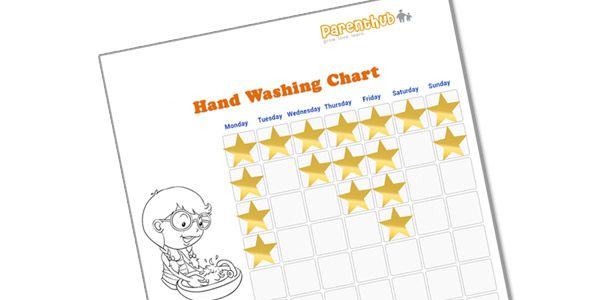Age
2 – 5 years
Duration of activity
This activity only lasts a minute but you’ll be able to do it every time your child washes their hands.
Materials/equipment
- Hand washing star chart
- Small stickers (stars, or another design your child loves)
Cost
The cost of printing the star chart is negligible and you should be able to pick up some stickers for $1-2 at your local bargain shop.
Preparation
- Print out the star chart at the beginning of each week.
- Ask your child to colour in the picture of the child washing their hands.
- Stick the chart near your child’s hand washing facilities, but far enough away so that it doesn’t get splashed with water.
What to do
- Every time your child washes their hands correctly, give them a sticker. If your child is just learning about hand washing, you might want to give them a sticker even if they don’t wash their hands perfectly- compliment them on what they did right and give them a sticker for that.
- Ask your child to put the sticker in the next available space on the star chart- this is also a great way to remind your child that proper hand washing is not finished until their hands are dry. If your child doesn’t dry their hands, they end up with wet stickers!
- At the end of each day, write in the space provided how many times your child washed their hands. Preschool aged kids might want to have a go at writing the numbers for themselves.
- Keep your hand washing chart for 2-3 weeks and compare this week with previous weeks. Talk to your child about how many times they washed their hands this week and ask whether it was more or less times than last week.
- Talk to your child about washing their hands next week and prepare a new chart to use.
For younger children
- Younger children still won’t be able to wash their hands independently, so you might want to give them stickers for remembering they need to wash their hands, or remembering to use soap and lather it up.
Tips
- You could use different colour stickers for different days of the week, so that you can also talk to your child about how often they wash their hands each day.
- Keep a record of how many times your child washes their hands each week so that you can compare.
- Use different stickers to make this activity more exciting for your child. For example you could use star stickers one week and different coloured dots another week. Or use stickers with your child’s favourite animal or character.
- Let your child make their own stickers for the chart. Cut coloured cardboard into small pieces that can be stuck on with sticky tape, or use blank stickers (e.g. labels stickers) so your child can draw pictures on the stickers.
Safety
- Supervise your child at all times while they are in the bathroom.
Download the hand washing star chart
Download stars
Download certificate
Educational outcomes
The hand washing star chart activity not only helps your child learn about hand washing; they also develop mathematical and fine motor skills as they do this activity.
Self care
Hand washing is an important part of self-care and it’s important for young children to participate in caring for themselves and develop a sense of independence. This activity encourages independent hand washing and shows your child that hand washing is an important activity that we all need to make time for in our daily routines.
Mathematical skills
This activity helps your child develop many early mathematical skills:
- Counting the number of times your child washed their hands is a great way to practice counting with your child. From about four years of age, your child will probably be able to count past ten, but even before they can count for themselves, they will be learning just from hearing you count.
- When you write (or help them write) the number of times they’ve washed their hands during the week you’ll be teaching them how the numerals represent a number of objects (in this case the number of stickers on the page).
- Discussing how often they wash their hands using words like more and less will also be developing their mathematical vocabulary.
- Collecting, organising, displaying and analysing information using tables and charts. It’s important to not only make the start chart with them but also to talk about the information and get your child to describe what they see (e.g. this week I washed my hands more or less than last week).
- Discussing the chart will also help your child to develop their mathematical vocabulary. For example they will learn:
- Comparative words like more and less.
- Day of the week.
- As your child monitors their hand washing each day, they will also be learning about time and sequence. They will learn new words to describe time like morning and afternoon, for example if you take time out to count how many times they washed their hands in the morning, before you start putting stickers for the afternoon in the hand washing chart. Seeing the days of the week on the chart will also help them learn about the sequence of time, for example that Wednesday always comes after Tuesday.
Fine motor skills
Colouring in the star chart picture will help your child develop the small muscles in their fingers which allow them to write and do other fiddly things. Peeling and sticking the stickers on the chart is also a fiddly task that will help improve your child’s pincer grip, that is, the grip they use to hold objects using only the thumb and index finger. Children generally begin holding objects with their palm and finger, before they develop the ability to manipulate objects with only a finger and thumb. Developing pincer grip early in life will help your child to do things like fasten buttons, write neatly and grasp small objects throughout their life. Activities like the star chart which provide them opportunities to use their pincer grip muscles is a great way to help them develop strength and dexterity.
Putting stickers or writing on a chart fixed to the wall at or above eye level also develops upper body strength in the shoulder muscles. Developing strength in the shoulders and arms provides the foundation kids need to fully develop their fine motors skills.
Language and literacy
The hand washing star chart also provides many opportunities for children to develop their language and literacy skills. Every time you talk to them about the chart, you’re helping them practice their language skills, for example they will learn new words when they talk to you and how to put the words together to form a sentence. They will develop literacy skills from reading the days of the week and other words on the chart.
More information about hand washing games and activities.
References
- Virginia Early Childhood Development Alignment Program. Milestones of child development- A guide to young children’s learning and development from birth to kindergarten. 2009. (cited 26 July 2013). Available from: (URL Link)
- Healthy Childhood Manitoba. What Early Childhood Educators need to know about Fetal Alcohol Spectrum Disorder. 2010. (cited 16 February 2014. Available from: (URL Link)
- Michigan State University. Helping Children Prepare for Academic Success. 2014. (cited 16 February 2014. Available from: (URL Link)



 (6 votes, average: 4.33 out of 5)
(6 votes, average: 4.33 out of 5) 







